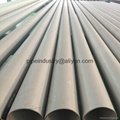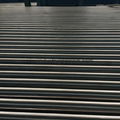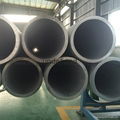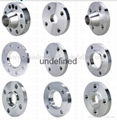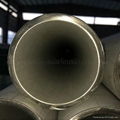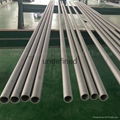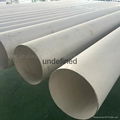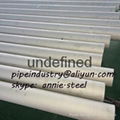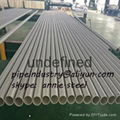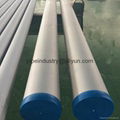| Model: | - |
|---|---|
| Brand: | - |
| Origin: | Made In China |
| Category: | Metallurgy , Mining & Energy / Metallurgy & Mining / Stainless Steel |
| Label: | tp310s , stainless steel pipe , 301H austenitic pipe |
| Min. Order: | - |
| Last Online:31 Jul, 2020 |
Alloy 310 310S austenitic stainless steel is typically used for elevated temperature applications. Its high chromium and nickel content provides comparable corrosion resistance, superior resistance to oxidation, and the retention of a larger fraction of room temperature strength than the common austenitic Alloy 304. Stainless Steel 310/310S is an austenitic heat resisting alloy with excellent resistance to oxidation under mildly cyclic conditions to 2100ºF. Its high chromium and nickel contents provide comparable corrosion resistance, superior resistance to oxdation and the retention of a larger fraction of roomtemperature strength.
310 is a highly alloyed austenitic stainless steel used for high temperature application. The high chromium and nickel content give the steel excellent oxidation resistance as well as high strength at high temperature. This grade is also very ductile, and has good weldability enabling its widespread usage in many applications.
Typical Applications Grade 310/310S is used in fluidised bed combustors, kilns, radiant tubes, tube hangers for petroleum refining and steam boilers, coal gasifier internal components, lead pots, thermowells, refractory anchor bolts, burners and combustion chambers, retorts, muffles, annealing covers, saggers, food processing equipment, cryogenic structures.
310 Stainless Steel, combining excellent high temperature properties with good weldability and ductility, is designed for high temperature service. 310 resists oxidation in continuous service at temperatures up 1150°C provided reducing sulfur gases are not present. 310 is also used for intermittent service at temperatures up to 1040°C.
310 /310S Technical Data: 310S is the low carbon version of SX 310 and is s ested for applications where sensitisation, and subsequent corrosion by high temperature gases or condensates during shutdown may pose a problem. SX 310 is manufactured in accordance with ASTM A 167 and SX 310S
Typical Applications:310/310S find wide application in all high-temperature environments where scaling and corrosion resistance, as well as high temperature strength and good creep resistance, are required
Chemical Composition
C Mn P S Si Cr Ni Mo
310 0.25 max 2.0 max 0.045 max 0.030 max 1.0 max 24.0 - 26.0 19.0 - 22.0
310S 0.08 max 2.0 max 0.045 max 0.030 max 1.0 max 24.0 - 26.0 19.0 - 22.0 0.75
310H 0.04-0.10 2.0 max 0.045 max 0.030 max 1.0 max 24.0 - 26.0 19.0 - 22.0 --
Typical Properties in the Annealed Condition
The properties quoted in this publication are typical of mill production and unless indicated should not be regarded as guaranteed minimum values for specification purposes.
1. Mechanical Properties at Room Temperature
310 310S
Typical Minimum Typical Minimum
Tensile Strength, MPa
625 515 575 515
Yield Stress (0.2 % offset), MPa 350 205 290 205
Elongation (Percent in 50mm) 50 40 50 40
Hardness (Brinell) 172 - 156 -
Endurance (fatigue) limit, MPa 260 - 260 -
2. Properties at Elevated Temperatures
The values quoted are those for 310.
Enquire for data on 310S .
Short Time Elevated Temperature Tensile Strength
Temperature, oC 550 650 750 850 950 1050
Tensile Strength, MPa 550 430 280 180 90 50
Creep data
Stress to develop a creep rate of 1% in the indicated time at the indicated temperature.
Time TemperatureoC 550 600 650 700 750 800
10 000 h Stress MPa 110 90 70 40 30 15
100 000 h Stress MPa 90 75 50 30 20 10
Creep Rupture Stress
Time Temperature oC 600 700 800 900 1000
1 000 h Stress MPa 190 110 50 35 15
10 000 h Stress MPa 170 70 35 20 10
100 000 h Stress MPa 110 55 25 10 2
Recommended Maximum Service Temperature
(Oxidising Conditions)
Continuous 1150oC
Intermittent 1035oC
Thermal Processing
1 Annealing Heat from 1050 to 1150oC and water quench This treatment ensures that all carbides are in
Physical Properties of 310S/310H Alloys in the Annealed Condition
Tensile Strength
Yield Strength
Alloy UNS psi MPa ksi psi MPa ksi Elongation in 2 inches (min.) % Grain Size Req. Maximum Hardness Modulus of Elasticity (x106 psi) Mean Coefficient of Thermal Expansion (IN./IN./°F x 10-6) Thermal Conductivity
(BTU-in/ft2-h-°F)
310S S31008 75,000 515 75 30,000 205 30 35 — 90 Rb 29.0 9.2 116
310H S31009 75,000 515 75 30,000 205 30 35 6 or coarser 90 Rb 29.0 9.2 116
Composition of 310S/310H stainless steel pipe
Grade 310S 310H
UNS Designation S31008 S31009
Carbon (C) Max. 0.08 0.04– 0.10
Manganese (Mn) Max. 2.00 2.00
Phosphorous (P) Max. 0.045 0.045
Sulphur (S) Max. 0.030 0.030
Silicon (Si) Max. 1.00 1.00
Chromium (Cr) 24.0–26.0 24.0–26.0
Nickel (Ni) 19.0–22.0 19.0–22.0
Molybdenum (Mo) — —
Nitrogen (N) — —
Iron (Fe) Bal. Bal.
Other Elements — —
310S/310H Product Range
Alloy UNS Designation Werkstoff NR.
310S S31008 1.4845
310H S31009 —
*Note: The specifications noted including ASTM, ASME, or other applicable authorities are correct at the time of publication. Other specifications may apply for use of these materials in different applications.
Principal Design Features The strength of this alloy is a combination of good strength and corrosion resistance in temperatures up to 2100oF (1149oC). Due to its relatively high chromium and nickel content it is superior in most environments to 304 or 309 stainless.
Applications Oven linings, boiler baffles, kilns, lead pots, radiant tubes, annealing covers, saggers, burners, combustion tubes, refractory anchor bolts, fire box sheets, furnace components and other high temperature containers.
Machinability This alloy machines similarly to type 304 stainless. Its chips are stringy and it will work harden rapidly. It is necessary to keep the tool cutting at all times and use chip breakers.
Welding Most of the austenitic stainless steels can be readily welded using fusion or resistance methods. Oxyacetylene welding is not recommended. Filler metal should be AWS E/ER 310.
Hot Working Most common hot work methods can be successfully performed after uniform heating to 2150 F (1177 C). Do not forge below 1800 F (982 C). Rapid cooling is required to maximize corrosion resistance.
Cold Working Although this alloy has a high work hardening rate, it can be drawn, headed, upset, and stamped. Full annealing is required after cold work to remove internal stress.
Annealing 1900-2050 F (1038-1121 C) water quench.
Principal Design Features The strength of this alloy is a combination of good strength and corrosion resistance in temperatures up to 2100 F (1149 C). Due to its relatively high chromium and nickel content it is superior in most environments to 304 or 309 stainless.
Hardening This alloy does not respond to heat treatment. Cold work will cause an increase in both hardness and strength.
email: sales@shangdunmetals.com
